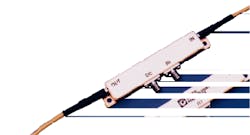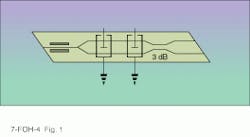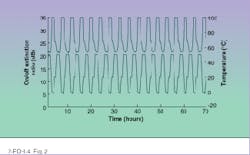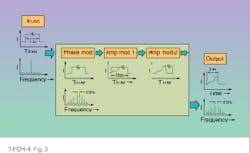Optical modulators find wider use in CATV and telecommunications
F. J. LEONBERGER, S. W. MERRITT, and P. G. SUCHOSKI
Lithium niobate (LiNbO3) integrated-optical (I-O) devices have become key components in a variety of commercial applications within the past several years and are available from about ten sources worldwide.1 Interferometric modulators and more-complex interferometric I-O devices are components in cable-television (CATV) distribution systems, long-haul telecommunication links, radio-frequency (RF) analog-transmission systems, and additional instrumentation applications. As the volume of components being manufactured has increased, process improvements have resulted in enhanced performance, reliability, reproducibility, and stability. Module-level products including the I-O components and electronic interface circuitry have been developed for specific applications.
Integrated-optical devices consist of optical waveguides patterned on dielectric substrates. Electric fields applied across waveguides on electro-optic substrates such as LiNbO3 change the index of refraction and hence the optical length of the waveguide. A phase modulator consists of a waveguide section with a pair of electrodes across it. An interferometer is formed by splitting an input waveguide into two optical paths and recombining the paths at a point further along the substrate. By adding metallized patterns so that electric fields can be generated across the interferometric paths, the relative phase of the optical fields upon recombination can be controlled resulting in constructive/destructive interference, or intensity modulation.
Integrated-optical devices for cable television
Integrated-optical modulators have been used with 1320-nm CATV transmitters for several years, offering performance improvement in several areas and economic advantages over conventional Mach-Zehnder devices. Transmitters include diode-pumped Nd:YAG laser sources operating at power levels in excess of 100 mW. In densely populated areas, I-O modulators permit multiple nodes to be fed from a single transmitter. Alternately, the modulators can double the maximum transmission distance for a point-to-point link over that offered by transmitters using directly modulated distributed-feedback lasers.
When balanced-bridge modulators rather than Mach-Zehnder devices are used, two optical outputs are available from the modulator instead of one. Optical power normally dissipated in a Mach-Zehnder device is available at the second output, resulting in a doubling of the optical power available to the user.
Long-distance transmission of high-power optical signals is limited by the onset of stimulated Brillouin scattering (SBS) in the fiber. At power levels well below the onset of the saturation of transmitted optical power, the nonlinearities associated with SBS result in the generation of intermodulation products and increased noise in the detected signal. Because SBS is a coherent effect, it can be minimized by broadening the linewidth of the source. This can be accomplished by phase modulation of the optical signal. A phase modulator is included on some modulator chips for CATV applications to allow line broadening without increasing the number of optical components or the insertion loss of the optical path (see Fig. 1).Cable-television operation requires transmission of 40 to 80 or more signals at composite modulation indices greater than 25%. Slight deviations from linearity result in the generation of intermodulation products that can compromise picture quality.
Bias-control circuitry maintains the operating point of the modulator at exactly the half intensity point to minimize even-order distortion products, while odd-order products are minimized using either electronic predistortion or optical linearization. Second- and third-order products are maintained at levels less than 65 dB using these techniques. A low-level, low-frequency tone is added to the RF input signal in the real-time control loops that maintain the correct operating point of the modulator. This signal and its harmonics are monitored and processed to generate an error signal that is used to adjust the operating point. Devices including the modulator, bias-control circuitry, and a photodiode for detecting the control signal are typically supplied to customers.
To meet CATV transmission requirements, the RF and optical components must provide a flat frequency response over the band of interest. Many installations in the USA currently operate over 550 MHz, while European frequency plans generally cover 860 MHz. As additional services become available, it is expected that the bandwidth of systems will increase to one gigahertz.
Devices for telecommunications
External modulation was first deployed in telecommunications on submarine routes. Current systems incorporate optical amplifier technology, operate at 1550 nm, and transmit data at rates up to 5 Gbits/s. Key elements in achieving these system level specifications for long-distance transmission are I-O external modulators that feature chirpless encoding of the data stream. Dispersion compensation properties may be incorporated into the I-O designs for next-generation 10-Gbit/s systems.
External modulators have been incorporated in wavelength-division-multiplexed systems, in which frequency control and chirpless transmission are intimately related to system performance and product value. Commercially available acousto-optic tunable filters combine optical-waveguide and surface acoustic-wave technology on a LiNbO3 substrate. High-performance products are being developed for wavelength-switching applications in telecommunications networks.
Large numbers of terrestrial 2.4-Gbit/s SONET/SDH systems have been deployed worldwide over the past several years. While early hardware incorporated directly modulated 1320-nm sources, the latest transmission products operate at 1550 nm with LiNbO3 external modulators. Operation at the longer wavelength reduces fiber loss from from 0.4 to 0.2 dB/km and allows the inclusion of optical amplifiers. This results in a repeater spacing from approximately 40 km to several hundred kilometers, offering long-haul carriers the potential for significant savings in component, installation, and maintenance costs. However, the fiber used in many installations is not dispersion-shifted for 1550-nm operation. Further, erbium-doped fiber amplifiers are incompatible with chirped signals. These issues can be avoided by the chirpless encoding capabilities of external modulators, allowing existing fiber networks to support transmission at 1550 nm.
Development of LiNbO3 devices for telecommunications applications has led to long-term device reliability and stability and improved packaging. To meet reliability specifications set forth by organizations such as Bellcore (Red Bank, NJ), the devices must also display long-term bias-point stability. Electronic bias-point control was an early solution to this problem. In a more recent approach, devices are passively biased to the correct operating point during manufacture, eliminating the need for this circuit.2 On/off extinction ratios in excess of 20 dB are maintained over temperature ranges of 0° to 50° C in static temperature environments and during thermal cycling at rates to 5°/min. (see Fig. 2).Lithium niobate modulators are used in transmission systems at frequencies as high as 20 GHz and over optical bandwidths to 75 GHz.3 One advantage associated with external modulators in microwave-frequency systems is high dynamic range. In addition, it is possible to physically separate the laser source from the modulator, reducing heat dissipation at the modulator location and allowing a single laser source to power multiple modulators.
2 × 2 switches
Known as balanced bridge modulators, 2 × 2 interferometric switches are beginning to find application in optical instruments and fiber-sensor systems. These devices can be passively biased at either the 3-dB point, the cross state, or the bar state. By applying a voltage comparable to the half-wave voltage of the device, light can be rapidly switched between the two output ports. Bandwidth on these devices can be in excess of 10 GHz, leading to very short rise- and falltimes. Two primary applications for these devices currently are short pulse generation in optical time-domain reflectometers and multiple fiber-sensor sampling using time-division multiplexing techniques.
Custom design services are available from LiNbO3 I-O device vendors, allowing instrumentation engineers access to parts that meet their specific requirements. For example, devices operating at nonstandard wavelengths, modulators designed to offer high performance over user-specified frequency bands, and multifunction chips designed to minimize overall system cost have been delivered to customers (see Fig. 3).4Lithium niobate integrated-optical devices are critical components in several commercial products, most notably cable-television transmitters and multigigabit telecommunication systems. Navigation systems using fiberoptic gyroscopes, new products for antenna remoting, and custom devices for instrumentation applications provide additional market opportunities for this developing technology.
REFERENCES
1. F. J. Leonberger and S.W. Merritt, Proc. 7th European Conference on Integrated Optics (ECIO `95), Delft, The Netherlands, p. 475 (April 1995).
2. R. W. Ade, K. M. Kissa, A. M. Yurek, and S. W. Merritt, Proc. 15th European Symposium on Optoelectronics (Opto `95), Paris, France, p. 80, (March 1995).
3. K. Noguchi, H. Miyazawa, and O. Mitomi, "75-GHz Ti:LiNbO3 optical modulator," Technical Digest OFC `94, San Jose, CA, paper WB3 (February 1994).
4. R. B. Wilcox, "New approach to fusion laser master oscillator design," Proc.CLEO `92, summary of papers, p. 566 (1992).
F. J. Leonberger is vice president, chief technical officer, S. W. Merritt is marketing manager, and P. G. Suchoski is business development manager at Uniphase Telecommunications Products, 1289 Blue Hills Ave., Bloomfield CT 06002.



